Entry Database : PDB / ID : 3vroTitle Crystal structure of the tyrosine kinase binding domain of Cbl-c in complex with phospho-Src peptide Proto-oncogene tyrosine-protein kinase Src Signal transduction protein CBL-C Keywords / / / / / / / / Function / homology Function Domain/homology Component
/ / / / / / / / / / / / / / / / / / / / / / / / / / / / / / / / / / / / / / / / / / / / / / / / / / / / / / / / / / / / / / / / / / / / / / / / / / / / / / / / / / / / / / / / / / / / / / / / / / / / / / / / / / / / / / / / / / / / / / / / / / / / / / / / / / / / / / / / / / / / / / / / / / / / / / / / / / / / / / / / / / / / / / Biological species Homo sapiens (human)Method / / / / Resolution : 1.8 Å Authors Takeshita, K. / Tezuka, T. / Isozaki, Y. / Yamashita, E. / Suzuki, M. / Yamanashi, Y. / Yamamoto, T. / Nakagawa, A. Journal : J.Biochem. / Year : 2012Title : Structural flexibility regulates phosphopeptide-binding activity of the tyrosine kinase binding domain of Cbl-c.Authors : Takeshita, K. / Tezuka, T. / Isozaki, Y. / Yamashita, E. / Suzuki, M. / Kim, M. / Yamanashi, Y. / Yamamoto, T. / Nakagawa, A. History Deposition Apr 13, 2012 Deposition site / Processing site Revision 1.0 Mar 6, 2013 Provider / Type Revision 1.1 Nov 22, 2017 Group / Category / Item
Show all Show less
 Yorodumi
Yorodumi Open data
Open data Basic information
Basic information Components
Components Keywords
Keywords PTB domain / TKB (tyrosine kinase binding) domain / four-helix bundle (4H) / calcium-binding EF hand / divergent SH2 domain / Regulator of EGFR mediated signal transduction / Ubiquitously expressed / PROTEIN BINDING-Transferase complex
PTB domain / TKB (tyrosine kinase binding) domain / four-helix bundle (4H) / calcium-binding EF hand / divergent SH2 domain / Regulator of EGFR mediated signal transduction / Ubiquitously expressed / PROTEIN BINDING-Transferase complex Function and homology information
Function and homology information regulation of cell-cell adhesion / positive regulation of dephosphorylation / response to mineralocorticoid / Regulation of commissural axon pathfinding by SLIT and ROBO / ERBB2 signaling pathway / regulation of epithelial cell migration / entry of bacterium into host cell / positive regulation of protein transport /
regulation of cell-cell adhesion / positive regulation of dephosphorylation / response to mineralocorticoid / Regulation of commissural axon pathfinding by SLIT and ROBO / ERBB2 signaling pathway / regulation of epithelial cell migration / entry of bacterium into host cell / positive regulation of protein transport /  Regulation of gap junction activity /
Regulation of gap junction activity /  regulation of vascular permeability / BMP receptor binding / positive regulation of lamellipodium morphogenesis / cellular response to progesterone stimulus / positive regulation of integrin activation / Activated NTRK2 signals through FYN / negative regulation of focal adhesion assembly / positive regulation of protein processing / skeletal muscle cell proliferation / negative regulation of telomerase activity / intestinal epithelial cell development / Netrin mediated repulsion signals / regulation of intracellular estrogen receptor signaling pathway / CD28 co-stimulation / positive regulation of glucose metabolic process /
regulation of vascular permeability / BMP receptor binding / positive regulation of lamellipodium morphogenesis / cellular response to progesterone stimulus / positive regulation of integrin activation / Activated NTRK2 signals through FYN / negative regulation of focal adhesion assembly / positive regulation of protein processing / skeletal muscle cell proliferation / negative regulation of telomerase activity / intestinal epithelial cell development / Netrin mediated repulsion signals / regulation of intracellular estrogen receptor signaling pathway / CD28 co-stimulation / positive regulation of glucose metabolic process /  transcytosis / Activated NTRK3 signals through PI3K /
transcytosis / Activated NTRK3 signals through PI3K /  connexin binding / cellular response to fluid shear stress / response to acidic pH /
connexin binding / cellular response to fluid shear stress / response to acidic pH /  focal adhesion assembly / signal complex assembly /
focal adhesion assembly / signal complex assembly /  podosome / positive regulation of small GTPase mediated signal transduction / positive regulation of Ras protein signal transduction / Regulation of RUNX1 Expression and Activity /
podosome / positive regulation of small GTPase mediated signal transduction / positive regulation of Ras protein signal transduction / Regulation of RUNX1 Expression and Activity /  regulation of bone resorption / positive regulation of podosome assembly / branching involved in mammary gland duct morphogenesis / DCC mediated attractive signaling / adherens junction organization / EPH-Ephrin signaling / myoblast proliferation / Ephrin signaling / osteoclast development / negative regulation of mitochondrial depolarization /
regulation of bone resorption / positive regulation of podosome assembly / branching involved in mammary gland duct morphogenesis / DCC mediated attractive signaling / adherens junction organization / EPH-Ephrin signaling / myoblast proliferation / Ephrin signaling / osteoclast development / negative regulation of mitochondrial depolarization /  odontogenesis / cellular response to peptide hormone stimulus / Signal regulatory protein family interactions / cellular response to fatty acid / MET activates PTK2 signaling / regulation of early endosome to late endosome transport /
odontogenesis / cellular response to peptide hormone stimulus / Signal regulatory protein family interactions / cellular response to fatty acid / MET activates PTK2 signaling / regulation of early endosome to late endosome transport /  oogenesis /
oogenesis /  epidermal growth factor receptor binding / Regulation of KIT signaling / postsynaptic specialization, intracellular component / Signaling by ALK / Receptor Mediated Mitophagy / GP1b-IX-V activation signalling / CTLA4 inhibitory signaling / phospholipase activator activity / leukocyte migration / interleukin-6-mediated signaling pathway / DNA biosynthetic process / Fc-gamma receptor signaling pathway involved in phagocytosis / EPHA-mediated growth cone collapse / negative regulation of hippo signaling / p130Cas linkage to MAPK signaling for integrins / positive regulation of epithelial cell migration / positive regulation of Notch signaling pathway / Signaling by EGFR / cellular response to platelet-derived growth factor stimulus /
epidermal growth factor receptor binding / Regulation of KIT signaling / postsynaptic specialization, intracellular component / Signaling by ALK / Receptor Mediated Mitophagy / GP1b-IX-V activation signalling / CTLA4 inhibitory signaling / phospholipase activator activity / leukocyte migration / interleukin-6-mediated signaling pathway / DNA biosynthetic process / Fc-gamma receptor signaling pathway involved in phagocytosis / EPHA-mediated growth cone collapse / negative regulation of hippo signaling / p130Cas linkage to MAPK signaling for integrins / positive regulation of epithelial cell migration / positive regulation of Notch signaling pathway / Signaling by EGFR / cellular response to platelet-derived growth factor stimulus /  stress fiber assembly / negative regulation of epidermal growth factor receptor signaling pathway / positive regulation of smooth muscle cell migration / RUNX2 regulates osteoblast differentiation / Recycling pathway of L1 / regulation of heart rate by cardiac conduction / dendritic growth cone / progesterone receptor signaling pathway / stimulatory C-type lectin receptor signaling pathway / PECAM1 interactions / uterus development /
stress fiber assembly / negative regulation of epidermal growth factor receptor signaling pathway / positive regulation of smooth muscle cell migration / RUNX2 regulates osteoblast differentiation / Recycling pathway of L1 / regulation of heart rate by cardiac conduction / dendritic growth cone / progesterone receptor signaling pathway / stimulatory C-type lectin receptor signaling pathway / PECAM1 interactions / uterus development /  phospholipase binding / neurotrophin TRK receptor signaling pathway / GRB2:SOS provides linkage to MAPK signaling for Integrins /
phospholipase binding / neurotrophin TRK receptor signaling pathway / GRB2:SOS provides linkage to MAPK signaling for Integrins /  Long-term potentiation / RHOU GTPase cycle / negative regulation of telomere maintenance via telomerase / platelet-derived growth factor receptor signaling pathway
Long-term potentiation / RHOU GTPase cycle / negative regulation of telomere maintenance via telomerase / platelet-derived growth factor receptor signaling pathway
 Homo sapiens (human)
Homo sapiens (human) X-RAY DIFFRACTION /
X-RAY DIFFRACTION /  SYNCHROTRON /
SYNCHROTRON /  MOLECULAR REPLACEMENT /
MOLECULAR REPLACEMENT /  molecular replacement / Resolution: 1.8 Å
molecular replacement / Resolution: 1.8 Å  Authors
Authors Citation
Citation Journal: J.Biochem. / Year: 2012
Journal: J.Biochem. / Year: 2012 Structure visualization
Structure visualization Molmil
Molmil Jmol/JSmol
Jmol/JSmol Downloads & links
Downloads & links Download
Download 3vro.cif.gz
3vro.cif.gz PDBx/mmCIF format
PDBx/mmCIF format pdb3vro.ent.gz
pdb3vro.ent.gz PDB format
PDB format 3vro.json.gz
3vro.json.gz PDBx/mmJSON format
PDBx/mmJSON format Other downloads
Other downloads https://data.pdbj.org/pub/pdb/validation_reports/vr/3vro
https://data.pdbj.org/pub/pdb/validation_reports/vr/3vro ftp://data.pdbj.org/pub/pdb/validation_reports/vr/3vro
ftp://data.pdbj.org/pub/pdb/validation_reports/vr/3vro Links
Links Assembly
Assembly
 Components
Components / RING finger protein 57 / SH3-binding protein CBL-3 / SH3-binding protein CBL-C
/ RING finger protein 57 / SH3-binding protein CBL-3 / SH3-binding protein CBL-C
 Homo sapiens (human) / Gene: CBLC / Plasmid: pGEX6p-1 / Production host:
Homo sapiens (human) / Gene: CBLC / Plasmid: pGEX6p-1 / Production host: 
 Escherichia coli (E. coli) / Strain (production host): DH5a / References: UniProt: Q9ULV8
Escherichia coli (E. coli) / Strain (production host): DH5a / References: UniProt: Q9ULV8 / Proto-oncogene c-Src / pp60c-src / p60-Src
/ Proto-oncogene c-Src / pp60c-src / p60-Src
 Homo sapiens (human)
Homo sapiens (human) non-specific protein-tyrosine kinase
non-specific protein-tyrosine kinase Water
Water X-RAY DIFFRACTION / Number of used crystals: 1
X-RAY DIFFRACTION / Number of used crystals: 1  Sample preparation
Sample preparation
 SYNCHROTRON / Site:
SYNCHROTRON / Site:  SPring-8
SPring-8  / Beamline: BL44XU / Wavelength: 0.9 Å
/ Beamline: BL44XU / Wavelength: 0.9 Å : 0.9 Å / Relative weight: 1
: 0.9 Å / Relative weight: 1 
 molecular replacement
molecular replacement Processing
Processing :
:  MOLECULAR REPLACEMENT / Resolution: 1.8→29.89 Å / Cor.coef. Fo:Fc: 0.957 / Cor.coef. Fo:Fc free: 0.931 / WRfactor Rfree: 0.1937 / WRfactor Rwork: 0.1561 / Occupancy max: 1 / Occupancy min: 0.5 / FOM work R set: 0.8741 / SU B: 2.448 / SU ML: 0.077 / SU R Cruickshank DPI: 0.124 / SU Rfree: 0.1228 / Cross valid method: THROUGHOUT / σ(F): 0 / ESU R: 0.124 / ESU R Free: 0.123 / Stereochemistry target values: MAXIMUM LIKELIHOOD
MOLECULAR REPLACEMENT / Resolution: 1.8→29.89 Å / Cor.coef. Fo:Fc: 0.957 / Cor.coef. Fo:Fc free: 0.931 / WRfactor Rfree: 0.1937 / WRfactor Rwork: 0.1561 / Occupancy max: 1 / Occupancy min: 0.5 / FOM work R set: 0.8741 / SU B: 2.448 / SU ML: 0.077 / SU R Cruickshank DPI: 0.124 / SU Rfree: 0.1228 / Cross valid method: THROUGHOUT / σ(F): 0 / ESU R: 0.124 / ESU R Free: 0.123 / Stereochemistry target values: MAXIMUM LIKELIHOOD Movie
Movie Controller
Controller


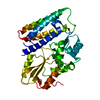
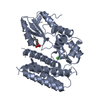
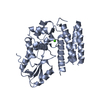







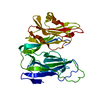

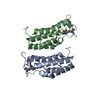

 PDBj
PDBj

































